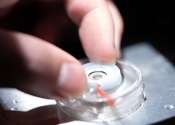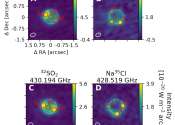New method could cut waste from drug production
Scientists have developed a sustainable new way of making complex molecules, which could greatly reduce waste produced during drug manufacturing, a study suggests.

Scientists have developed a sustainable new way of making complex molecules, which could greatly reduce waste produced during drug manufacturing, a study suggests.
Analytical Chemistry
18 hours ago
0
1

A new computer process developed by chemists at ETH Zurich makes it possible to generate active pharmaceutical ingredients quickly and easily based on a protein's three-dimensional surface. The new process, detailed in Nature ...
Biochemistry
20 hours ago
1
7

A mystery that has puzzled the scientific community for more than 50 years has finally been solved. A team from Linköping University, Sweden, and Helmholtz Munich have discovered that a certain type of chemical reaction ...
Biochemistry
21 hours ago
0
1

Despite huge advances in our understanding of COVID-19 over the past four years, the disease is still very much among us—and there remains a lot to learn.
Cell & Microbiology
21 hours ago
0
8

It's the most fundamental of processes—the evaporation of water from the surfaces of oceans and lakes, the burning off of fog in the morning sun, and the drying of briny ponds that leaves solid salt behind. Evaporation ...
General Physics
Apr 23, 2024
0
178

New research from the group of MIT Professor Brett McGuire has revealed the presence of a previously unknown molecule in space. The team's open-access paper, "Rotational Spectrum and First Interstellar Detection of 2-Methoxyethanol ...
Astronomy
Apr 23, 2024
0
689

Regenerating damaged tissues or organs has been a dream of scientists for decades. Now, researchers at the FMI and Novartis Biomedical Research have discovered a new molecule that activates a protein involved in regeneration. ...
Biotechnology
Apr 23, 2024
0
28

Helicenes are organic molecules that gained widespread popularity due to their unique helical π-conjugated molecular structure, where the benzene rings are ortho-fused, resulting in excellent chiroptical properties such ...
Analytical Chemistry
Apr 23, 2024
0
1

The origin of life on Earth is still enigmatic, but we are slowly unraveling the steps involved and the necessary ingredients. Scientists believe life arose in a primordial soup of organic chemicals and biomolecules on the ...
Astrobiology
Apr 21, 2024
1
1765

A team of geologists and planetary scientists from the California Institute of Technology, the University of California Santa Cruz, New York University, and NASA Goddard Space Flight Center reports evidence that Io's volcanic ...
A molecule is defined as a sufficiently stable, electrically neutral group of at least two atoms in a definite arrangement held together by very strong (covalent) chemical bonds. Molecules are distinguished from polyatomic ions in this strict sense. In organic chemistry and biochemistry, the term molecule is used less strictly and also is applied to charged organic molecules and biomolecules.
In the kinetic theory of gases the term molecule is often used for any gaseous particle regardless of its composition. According to this definition noble gas atoms are considered molecules despite the fact that they are composed of a single non-bonded atom.
A molecule may consist of atoms of a single chemical element, as with oxygen (O2), or of different elements, as with water (H2O). Atoms and complexes connected by non-covalent bonds such as hydrogen bonds or ionic bonds are generally not considered single molecules.
No typical molecule can be defined for ionic crystals (salts) and covalent crystals (network solids), although these are often composed of repeating unit cells that extend either in a plane (such as in graphene) or three-dimensionally (such as in diamond or sodium chloride). The theme of repeated unit-cellular-structure also holds for most condensed phases with metallic bonding. In glasses (solids that exist in a vitreous disordered state), atoms may also be held together by chemical bonds without any definable molecule, but also without any of the regularity of repeating units that characterises crystals.
This text uses material from Wikipedia, licensed under CC BY-SA